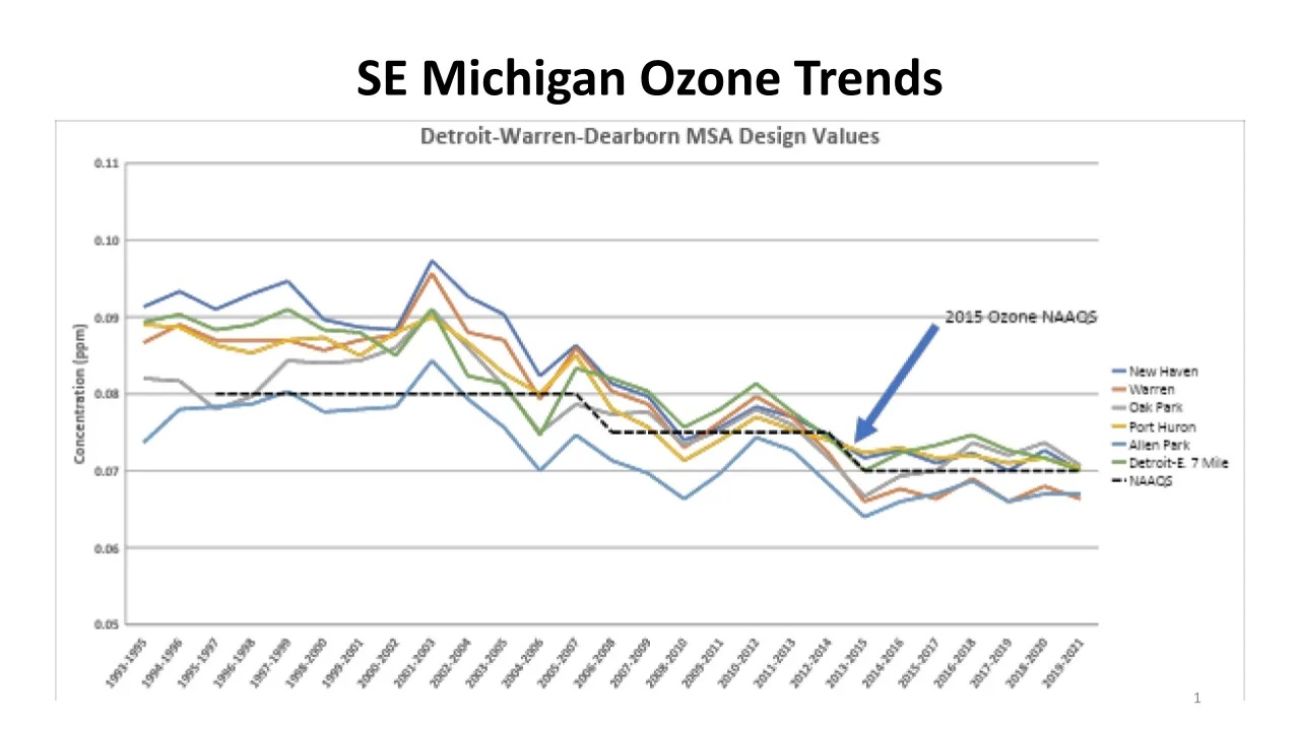Michigan asks EPA to allow it to discount Detroit air quality data

State regulators this year sought approval from the U.S. Environmental Protection Agency to ignore certain air quality data, paving the way for metro Detroit to avoid ozone regulation under the Clean Air Act.
The move in January supports the state’s pending request for the EPA to remove the region’s “non-attainment” status for ozone under the act based on monitoring data for 2019-2021.

This story also appeared on Planet Detroit
It comes at a time when rates of asthma, which is caused and triggered by ozone, are rising in Detroit, particularly in Black communities. Detroit was named the worst city to live in with asthma by the Asthma and Allergy Foundation of America in 2022.
Related:
- Utilities gave big to Michigan lawmakers now weighing reforms, records show
- Michigan stopped Ohio toxic waste last week, but we import waste every day
- Michigan voters are skeptical of EVs and the value of college in new poll
Michigan’s Department of Environment, Energy and Great Lakes on Jan. 26 requested that the EPA allow it to discount certain ambient air ozone measurements collected on June 24 and 25, 2022, at the East Seven Mile monitor in Detroit that exceeded air quality standards, arguing ozone levels during those days were influenced by western wildfires and do not reflect typical conditions.
Federal regulations allow states to request the exclusion of “exceptional events” outside of regulatory control – things like wildfires, dust events, stratospheric ozone intrusions and volcanic and seismic activities.
“The monitoring data, with the exceptional event exclusion, accurately reflect improvements to air quality that can be influenced by regulatory control in Michigan,” EGLE spokesperson Hugh McDiarmid told Planet Detroit, noting that the EPA on Feb. 3 concurred with the state’s request to ignore the data.
By discounting data measured at that location on those days, the region’s overall air quality data measurements across a network of six monitors pushed it below the National Ambient Air Quality Standards for ozone for 2022, paving the way for EPA to grant EGLE’s request.
However, a memo filed by the Great Lakes Environmental Law Center suggests that the state cherry-picked the data it wanted removed to allow the region to come below air quality standards while failing to evaluate local emissions sources that could account for the elevated ozone on the days in question.
Metro Detroit has been in a “non-attainment” status for ozone since 2015 when the EPA updated its air quality standards for ozone. The status triggers additional regulations under the Clean Air Act, such as a review of large new ozone sources, offset requirements and tighter limits on the use of certain coatings, adhesives, and solvents that release ozone precursor pollutants like nitrogen oxides (NOx) and volatile organic compounds (VOCs). The region would also be required to implement vehicle emissions testing.
According to the law center’s memo, the state and EPA have repeatedly delayed the implementation of regulations that would protect public health by regulating ozone since 2015.
The regulations would impact area auto plants, which are the top emitters of VOCs, according to Nicholas Leonard, executive director of the law center.
“They would all be subject to more stringent emissions regulations,” Leonard told Planet Detroit, noting that full data on VOC emissions are not yet available for the Stellantis Mack Avenue Plant, which has come under fire for VOC-related odors connected to its painting operation. Detroit City Council recently called on the company to buy out neighboring residents.
According to data provided by McDiarmid, ozone levels in the metro Detroit region have steadily improved since 2015.
“EGLE continues to identify and implement effective measures to reduce emissions in the southeast Michigan area and across the state,” he said in a statement. “This work will continue regardless of the region’s attainment status.

However, McDiarmid acknowledges that those improvements are not felt uniformly across the region.
“We acknowledge that there are geographic pockets within the region – particularly in heavily industrialized areas – that experience air quality concerns differently than what is experienced regionally,” McDiarmid told Planet Detroit. “We work through our permitting and oversight processes to better protect those communities.”
That’s not welcome news for Kathleen Slonager, executive director of the Asthma and Allergy Foundation of Michigan.
“It means asthma rates will keep going up,” Slonager told Planet Detroit.
The asthma mortality rate in Detroit in 2017-2019 was about three times the rate for Michigan.
McDiarmid said EGLE is “engaged with additional efforts to both better understand and address the impact of poor air quality on communities that are overburdened with multiple issues like asthma and marginalization,” pointing to efforts like assisting schools, working with community partners to develop community resiliency plans, and working with groups like the Asthma Collaborative of Detroit.
But there is a limit to how resilient communities can be when regulators avoid regulations that can reduce pollutants that harm public health, according to Slonager.
“If we don’t start taking air quality more seriously and having the standards be more in line with what’s truly healthy, asthma and other chronic diseases will continue to rise,” she said.
Public comment on EGLE’s request to remove EPA’s nonattainment designation for ozone is open through March 6. Comments can be submitted via email to arra.sarah@epa.gov or online.
Michigan Environment Watch
Michigan Environment Watch examines how public policy, industry, and other factors interact with the state’s trove of natural resources.
- See full coverage
- Subscribe
- Share tips and questions with Bridge environment reporter Kelly House
Michigan Environment Watch is made possible by generous financial support from:
Our generous Environment Watch underwriters encourage Bridge Michigan readers to also support civic journalism by becoming Bridge members. Please consider joining today.
See what new members are saying about why they donated to Bridge Michigan:
- “In order for this information to be accurate and unbiased it must be underwritten by its readers, not by special interests.” - Larry S.
- “Not many other media sources report on the topics Bridge does.” - Susan B.
- “Your journalism is outstanding and rare these days.” - Mark S.
If you want to ensure the future of nonpartisan, nonprofit Michigan journalism, please become a member today. You, too, will be asked why you donated and maybe we'll feature your quote next time!






